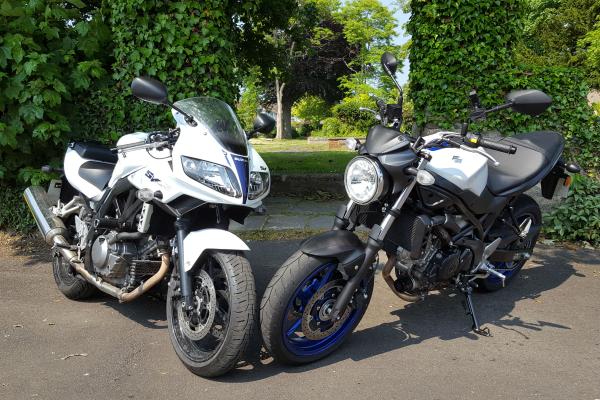
Can Suzuki’s new SV650 fill the space that will be left by the demise of the SV650S?
FOR years it’s been one of the best value motorcycles on the market, offering unrivalled performance and all-round competence at the price, as happy on a track day as the morning commute.
That’s why it’s been a first big bike for thousands, and simply an affordable bike for thousands more.
Of course I’m talking about the half-faired Suzuki SV650S, as well as the SV650, the naked version of the same machine. The latter was superseded some years ago by the SFV650 Gladius. And now the SV650S is being slowly discontinued too. It’s still listed on Suzuki’s website but once existing stock is gone, it’s gone.
Oh, but wait. There is a new 2016 Suzuki SV650. It’s quite different to the old SV, with a steel frame instead of aluminium, and it looks oddly familiar. Where have we seen it before? That’s it – it’s a Gladius.
What’s really happened is Suzuki has realised the SV name has more credibility than the Gladys’ and decided to recycle it for an updated version of the latter.
It’s marketing smoke and mirrors - but they are taking away the old SV. So the important question is, is this new SV a worthy successor? Luckily I own a very late SV650S, bought new in 2013, and for about a month I’ve been riding a new 2016 SV650 as a long-term test bike - so I should be able to take a stab at an answer.
If the name reshuffle caused confusion (and apparently it did, with some of Visordown’s rival motorcycle publications failing to note the new SV650 was actually an updated Gladius) it wasn’t helped by Suzuki’s press release.
The release told us it made 4hp more and weighed 8kg less than its predecessor, without clarifying that the predecessor referred to was the Gladius.
If they’re calling it the SV, they should obviously be comparing it to the old SV, and in that case it weighs 1kg more than its predecessor. Power is still up by 4hp, from 71hp to 75hp. Torque is the same, at 47lbft.
Where the action happens is different, with peak power at 8,500rpm on the new SV and 9,000rpm on the new one. This is a key difference between the two engines: The old one feels revier, with a red line at 11,000rpm instead of 10,000. The new one feels stronger in the mid-range, more ready to wheelie. The old one’s power delivery is more like a sports bike; the new one’s more like a naked. Very sensible too, since that’s what they are. The old one has slightly taller gearing than the new one too, thanks to a 44-tooth rear sprocket where the new one has 45.
The suspension on the SV650S is on the soft side of adequate, usually equal to the demands made of a budget sports bike and not under-damped like Yamaha’s MT-07. The SV650’s set-up looks very similar (aside from having a non-adjustable fork instead of a pre-load adjustable one) - but it’s firmer.
The brakes make an interesting comparison, because they haven’t improved one bit. The brakes on mine are effective but often feel wooden and dated if I’ve just ridden something newer – except in the case of the newer SV. If anything, the front on that feels like it has less bite. Perhaps they’ll improve slightly with use. My bike’s on its second set of pads.
The steel chassis doesn’t have quite the unshakeable stability of the aluminium one. And of course the riding position is different, one sporty, the other upright and more comfortable. More comfortable for a while, anyway.
The new SV has Suzuki’s ‘Easy Start’ system, which means you press the button once and the starter motor turns until the engine fires. I hadn’t actually noticed this in practice until two minutes before writing this sentence, when I went outside to check it was real. It is. I can honestly say, in all the times I’ve started my SV, I have never suffered from a tired finger.
As the clutch is released, the new one automatically raises the revs slightly from idle (in case you haven’t) to avert stalling. I hadn’t noticed this either, because I have some small grasp of how to ride a motorcycle.
The old one has a fairing, which I notice every time I get on it. It’s literally more bike.
A sporty riding position is something I find I adjust to and forget about; a deafening wind trying to wrench my head off on the motorway isn’t.
Neither has my arse grown more tolerant to the new SV’s seat. It’s really unyielding. You can see at a glance that it’s thinly padded. After an hour on it, I’m ready to get off. The old one’s not exactly luxurious but I’m quite happy on it for two hours or more.
The case for the new bike isn’t improved by the addition of a pillion or luggage. The old one has a pillion grab-rail; the new one doesn’t. On the pillion grab-rail are hooks for bungee cords. I’ve replaced my grab-rail with an SW Motech rack but I can hook bungees onto that just the same. The other ends go on the pillion footrest hangers, allowing me strap a massive kit bag onto the pillion seat when I head off on bike launches.
The new SV has fold-away straps under the seat instead of luggage hooks. That might be okay if they weren’t too close to the pillion footrests. When I try to put the same bag on the pillion seat, it rocks forward and squashes me against the tank – which, incidentally, is 3.2 litres smaller than the old one.
The old SV has a much bigger space under the pillion seat, with two hooks for locking helmets to. The new one has nowhere to secure a helmet. And the tool kits. I don't need to say anything. Just look at the picture. On the rider's seat is the new bike's tool kit, on the pillion seat the old one's.
Fuel economy isn’t very different. On the same commute, including motorway and city, I got 55.6mpg on the new one and 54.5mpg on the old. I suppose that would add up to a saving over time.
Both machines are still made in Japan, an increasingly rare thing at this price.
Of course the SV is now Euro4-compliant, part of which means having ABS, something never offered even as an option in the UK on the old one. But the new SV isn’t the best advert for ABS I’ve ever tried. I’ve no idea what triggered it but on one occasion, at about 60mph on the approach to a roundabout, I found myself momentarily brake-less, although I was pulling hard on the lever. There’s no way the front was at any risk of locking. Luckily I was braking early enough to leave a margin for error.
There’s also more information on the new dash, including a fuel gauge, range till empty and a gear indicator. The old one doesn’t even have a fuel gauge, just a warning light.
I’m reluctant to criticise the new SV. It’s a terrific machine for the money. It’s got enough power and torque for an experienced rider to have a lot of fun, and it’s good that it’s gained a few hp. It handles well and it’s a great city bike, much more easily manoeuvrable at low speed than mine thanks to the high bars. It’s probably more accessible to novices.
My concern is that, if I was buying today, I might still get the old one, for £500 less, because its arena of usefulness is broader. It’s slightly more versatile, and I can only afford one bike so versatility is what I want.
That’s what I was going to say in my conclusion, but before publishing I had another go on each bike, on some twisty country roads.
On the new SV, listening to some music in my helmet, I found myself in a bit of a zone, nailing it on the straights, braking hard for corners and blasting past any car that had the ill-manners to be in the way. And I thought: Hang on. This is more fun, isn’t it?
The engine feels stronger everywhere in the range. There’s more bottom-end and mid-range punch but also a livelier-feeling top-end.
It’s more easily chucked about. The old SV650S is no lumbering heavyweight but the new one changes direction like a rabbit. Okay, not quite like a rabbit but you get the idea. The high bars help make it really nimble. It’s more compact with that smaller tank and of course the weight of the fairing and fairing frame over the front end is gone. The firmer suspension is less inclined to get ruffled as you up the pace. It’s surprisingly well-sprung for a machine at this price. While it may be possible to adjust the fork pre-load on the old bike, I never have.
Plus the new SV sounds fruitier. The SV650S is heavily muffled by that canon-sized silencer. On the new bike, the catalytic converter has been moved to under the shock linkage, allowing the silencer to be smaller, and it sounds more like a V-twin should, with a bit of burble and bark.
So perhaps I would find the extra £500 for this one after all, and fit a comfort seat and fly screen. Apart from anything else, it’s a newer model and that counts for a lot. It will probably hold its value better. Probably.
I’ve got a lot of plans for this long-term test, including taking both SVs on a track day, so I’m going to reserve judgement. In the meantime I’d be very interested to hear your thoughts. For now, I’m calling it a dead heat.
SPECIFICATIONS
Model tested: Suzuki SV650
Price: £5,499
Engine: 645cc 90° DOHC V-twin
Power: 75hp @ 8,500rpm
Torque: 47lbft @ 8,100rpm
Kerb weight: 197kg
Frame: Steel
Suspension: Pre-load adjustable shock, non-adjustable fork
Brakes: Two-piston Tokico calipers on twin 290mm floating front discs; single-piston Nissin caliper on 240mm rear disc, with ABS
Tyres: Dunlop Sportmax Qualifier 120/70-17 front, 160/60-17 rear
Seat height: 785mm
Tank capacity: 13.8 litres
Fuel economy: 55.6mpg (achieved); 73.6mpg (claimed)
Range (based on achieved fuel economy): 168 miles
Colours: White, blue, black
Availability: Now
Model tested: Suzuki SV650S
Price: £4,999
Engine: 645cc 90° DOHC V-twin
Power: 71hp @ 9,000rpm
Torque: 47lbft @ 7,200rpm
Kerb weight: 196kg
Frame: Aluminium
Suspension: KYB shock and 41mm fork, both pre-load adjustable
Brakes: Two-piston Tokico calipers on twin 290mm floating front discs; single-piston Nissin caliper on 240mm rear disc
Tyres: Dunlop Sportmax 120/60-17 front, 160/60-17 rear
Seat height: 800mm
Tank capacity: 17 litres
Fuel economy: 54.5mpg (achieved)
Range (based on achieved fuel economy): 203 miles
Colours: White, black
Availability: Now

